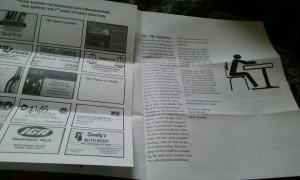My little IMO piece was printed in this month’s newsletter for the 7th Ward. They may regret asking me to write something. This photo is hard to read, so there is a copy/paste reprint down below.

For those who don’t know, the population of Youngstown, Ohio, dropped from 170,002 residents in the heyday of steel mills to less than 65,000 today. That left a lot of vacant houses. It’s great if you are looking to buy a fairly decent house on the cheap… mine was less than $20,000. Unfortunately, too many houses fell into decay, partly because out-of-town investors snatched up homes for pennies on the dollar and didn’t give a flying fig about taking care of the properties. Others just left… walked away. The house next door was abandoned years ago, owner address unknown, until the Land Bank acquired it last fall. After a thorough inspection, they opted to tear it down.
I did the #beingGladysKravitz thing and snapped some photos while peeking out my windows.

They did it right… followed EPA guidelines, removed basement block and everything was hauled off site. The vacant lot was left looking nice and tidy. Even the black-topped driveway was removed.
Hopefully, they got the bamboo out, too.
When the weather breaks, they will be back to plant grass and install a split rail fence across the front of the lot. If the people in the next house down wish to buy it, there will be no competition from me as I think it looks like it should become part of their yard. They don’t have a fence… I do.
On the next block over, the city street department demolished a house and left the lot in a royal mess. People are not happy. Neighbors are talking. They can see the difference between lots done right and demos gone bad. With hundreds of house already demolished and aggressive plans to tear down more, vacant lots dot our neighborhoods. We live here. We care.
Is it too much to ask those who don’t to do it right?
Ridding the city of dilapidated housing is good, but we need to think about the future, too. Vacant lots can enhance the city with green space, become urban gardens, or end up becoming just another form of urban blight. What is in the ground matters. So, that’s what I choose to write about.
Here’s the unedited version of my IMO (edited version in photo):
IMO, filling in the hole left after a demolition by smashing part of the house down into the basement and throwing dirt on top turns our vacant lots into mini unregulated landfills containing the same type of debris that requires annual testing to monitor leakage at state licensed C&DD (construction and demolition debris) landfills.
What is the long term effect?
The debris will rot over time, releasing heavy metals and chemicals that can leach into soil and waters. And it is not just lead from old paint. In fact, lead is not even on the list of 74 parameters that C&DD facilities are required to monitor. They are looking for Arsenic, Copper, Mercury, and a dozen other heavy metals. The list of 46 chemicals includes carcinogens like Benzene (used in paints, glues, resins, etc.) Licensed C&DD landfills have lots of rules, including disposal limits to protect their neighbors. They cannot bury debris within 100 feet of their property line or within 500 feet of an occupied dwelling. And yet, here we are, in an urban setting, with hundreds of mini landfills, containing the same type of debris with the same potential health hazards, located on vacant lots between houses in our own neighborhoods.
The practice must be stopped.
Yes, it costs more per demolition to do it right. But, what is the cost in the long run? Must our children suffer the health consequences? What is the cost to dig it up later, if a clean up is required?
Thankfully, most demolition contractors follow EPA guidelines, which suggest removing the basement, disposing all debris at a state licensed C&DD facility, and prepping the earth so the vacant lot can be beneficial to the city by providing green spaces that can used to help with storm water management.
IMO, the city should follow their example and also do it right.
Thanks for reading,
Nancy Barnes
UPDATE 4/25/2018: What I failed to mention, on request of the person who asked me to write my little IMO, is that the practice of burying demolition debris on-site is ILLEGAL in the State of Ohio unless you get an exemption from the EPA. The law also states that individuals seeking exemptions MUST PROVE that debris buried on-site is unlikely to have any adverse public health, safety, or environmental effect. The process of requesting an exemption requires a paper trail so I called the EPA.
Well, guess what… NO exemptions have been granted for any properties in the city of Youngstown, Ohio. If we submit addresses of vacant lots containing demolition debris to the Ohio EPA Division of Materials and Waste Management (DMWM), they will investigate and the city could be fined and/or required to clean up the sites.
I relayed this information to my councilwoman and a few other people at a meeting tonight and feedback was not exactly supportive. They don’t want to rock the boat. The city is tight on cash. It costs about $1,000 more per demo to do it right… if they have to do it right, then less houses will be demolished… what about the environmental impact? The cost of digging all that crap up later? I was told that if I wanted to take on the city, go ahead… as in what, on my own?
Well… hello Youngstown.




